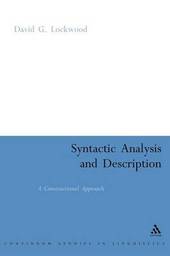
|
Syntactic Analysis and Description: A Constructional Approach
Paperback / softback
Main Details
| Title |
Syntactic Analysis and Description: A Constructional Approach
|
| Authors and Contributors |
By (author) David Lockwood
|
| Physical Properties |
| Format:Paperback / softback | | Pages:386 | | Dimensions(mm): Height 234,Width 156 |
|
| Category/Genre | Grammar and syntax |
|---|
| ISBN/Barcode |
9780826478764
|
| Classifications | Dewey:415 |
|---|
| Audience | | General | | Tertiary Education (US: College) | |
|---|
|
Publishing Details |
| Publisher |
Bloomsbury Publishing PLC
|
| Imprint |
Continuum International Publishing Group Ltd.
|
| Publication Date |
1 May 2005 |
| Publication Country |
United Kingdom
|
Description
This book is designed to teach undergraduate and beginning graduate students how to understand, analyse and describe syntactic phenomena in different languages. The book covers every aspect of syntax from the basics to more specialised topics, such as clitics, which have grammatical importance but cannot be used in isolation; and negation, in which a construction contradicts the meaning of a sentence. The approach taken combines concepts from different theoretical schools, which view syntax differently. These include M.A.K. Halliday's systemic functional linguistics, the stratificational school advocated by Sydney Lamb, and Kenneth L. Pike's tagmemic model. The emphasis of the book is on syntactic structures rather than linguistic meaning, and the book stresses the difference between a well-formed sentence and a meaningful one. The final chapter brings these two aspects together, to show the connections between syntax and semology. Each chapter concludes with exercises from a diverse range of languages and a list of major technical terms. The book also includes a glossary as an essential resource for students approaching this difficult subject for the first time.
Author Biography
David G. Lockwood is Professor of Linguistics at Michigan State University, USA. He is co-editor, with Michael Cummings, Peter H. Fries and William Spruiell, of Relations and Functions within and around Language (Continuum, 2001).
|